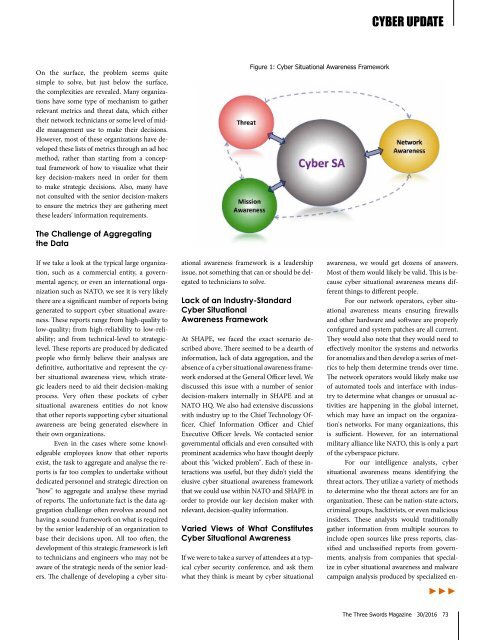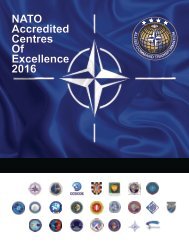TRIDENT ISSUE
7201_JWC_May2016_Magazine_ORIG_Low
7201_JWC_May2016_Magazine_ORIG_Low
You also want an ePaper? Increase the reach of your titles
YUMPU automatically turns print PDFs into web optimized ePapers that Google loves.
CYBER UPDATE<br />
On the surface, the problem seems quite<br />
simple to solve, but just below the surface,<br />
the complexities are revealed. Many organizations<br />
have some type of mechanism to gather<br />
relevant metrics and threat data, which either<br />
their network technicians or some level of middle<br />
management use to make their decisions.<br />
However, most of these organizations have developed<br />
these lists of metrics through an ad hoc<br />
method, rather than starting from a conceptual<br />
framework of how to visualize what their<br />
key decision-makers need in order for them<br />
to make strategic decisions. Also, many have<br />
not consulted with the senior decision-makers<br />
to ensure the metrics they are gathering meet<br />
these leaders' information requirements.<br />
Figure 1: Cyber Situational Awareness Framework<br />
The Challenge of Aggregating<br />
the Data<br />
If we take a look at the typical large organization,<br />
such as a commercial entity, a governmental<br />
agency, or even an international organization<br />
such as NATO, we see it is very likely<br />
there are a significant number of reports being<br />
generated to support cyber situational awareness.<br />
These reports range from high-quality to<br />
low-quality; from high-reliability to low-reliability;<br />
and from technical-level to strategiclevel.<br />
These reports are produced by dedicated<br />
people who firmly believe their analyses are<br />
definitive, authoritative and represent the cyber<br />
situational awareness view, which strategic<br />
leaders need to aid their decision-making<br />
process. Very often these pockets of cyber<br />
situational awareness entities do not know<br />
that other reports supporting cyber situational<br />
awareness are being generated elsewhere in<br />
their own organizations.<br />
Even in the cases where some knowledgeable<br />
employees know that other reports<br />
exist, the task to aggregate and analyse the reports<br />
is far too complex to undertake without<br />
dedicated personnel and strategic direction on<br />
"how" to aggregate and analyse these myriad<br />
of reports. The unfortunate fact is the data aggregation<br />
challenge often revolves around not<br />
having a sound framework on what is required<br />
by the senior leadership of an organization to<br />
base their decisions upon. All too often, the<br />
development of this strategic framework is left<br />
to technicians and engineers who may not be<br />
aware of the strategic needs of the senior leaders.<br />
The challenge of developing a cyber situational<br />
awareness framework is a leadership<br />
issue, not something that can or should be delegated<br />
to technicians to solve.<br />
Lack of an Industry-Standard<br />
Cyber Situational<br />
Awareness Framework<br />
At SHAPE, we faced the exact scenario described<br />
above. There seemed to be a dearth of<br />
information, lack of data aggregation, and the<br />
absence of a cyber situational awareness framework<br />
endorsed at the General Officer level. We<br />
discussed this issue with a number of senior<br />
decision-makers internally in SHAPE and at<br />
NATO HQ. We also had extensive discussions<br />
with industry up to the Chief Technology Officer,<br />
Chief Information Officer and Chief<br />
Executive Officer levels. We contacted senior<br />
governmental officials and even consulted with<br />
prominent academics who have thought deeply<br />
about this "wicked problem". Each of these interactions<br />
was useful, but they didn't yield the<br />
elusive cyber situational awareness framework<br />
that we could use within NATO and SHAPE in<br />
order to provide our key decision maker with<br />
relevant, decision-quality information.<br />
Varied Views of What Constitutes<br />
Cyber Situational Awareness<br />
If we were to take a survey of attendees at a typical<br />
cyber security conference, and ask them<br />
what they think is meant by cyber situational<br />
awareness, we would get dozens of answers.<br />
Most of them would likely be valid. This is because<br />
cyber situational awareness means different<br />
things to different people.<br />
For our network operators, cyber situational<br />
awareness means ensuring firewalls<br />
and other hardware and software are properly<br />
configured and system patches are all current.<br />
They would also note that they would need to<br />
effectively monitor the systems and networks<br />
for anomalies and then develop a series of metrics<br />
to help them determine trends over time.<br />
The network operators would likely make use<br />
of automated tools and interface with industry<br />
to determine what changes or unusual activities<br />
are happening in the global internet,<br />
which may have an impact on the organization's<br />
networks. For many organizations, this<br />
is sufficient. However, for an international<br />
military alliance like NATO, this is only a part<br />
of the cyberspace picture.<br />
For our intelligence analysts, cyber<br />
situational awareness means identifying the<br />
threat actors. They utilize a variety of methods<br />
to determine who the threat actors are for an<br />
organization. These can be nation-state actors,<br />
criminal groups, hacktivists, or even malicious<br />
insiders. These analysts would traditionally<br />
gather information from multiple sources to<br />
include open sources like press reports, classified<br />
and unclassified reports from governments,<br />
analysis from companies that specialize<br />
in cyber situational awareness and malware<br />
campaign analysis produced by specialized en-<br />
►►►<br />
The Three Swords Magazine 30/2016 73



